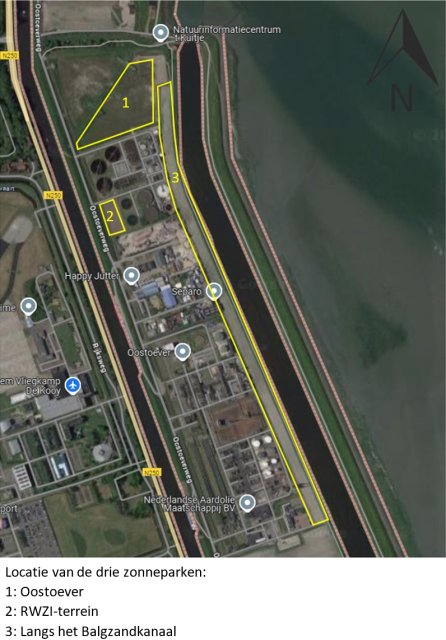Solar parks Den Helder
We want to construct three solar parks in Den Helder on and around the site of the sewage treatment plant (rwzi). On the strip of land along the Balgzand canal, HHNK is also constructing a nature strip.
Where does the project take place?

In Den Helder, solar parks are being constructed at three locations. On the Oostoever site, on the rwzi site and along the Balgzand Canal (Spuikanaal).
The wastewater treatment process at the rwzi consumes a lot of energy, especially the aeration process. By placing solar panels around the rwzi, we can sustainably generate a large part of the energy required on site. The design of the solar park along the Balgzand canal takes careful account of nature. Two nature strips will be constructed next to the solar park.
What will happen?
About 1,800 panels will be installed on the rwzi site, about 6,000 panels on the Oostoever site, and about 7,500 more along the Balgzand Canal. A total of about 15,300 solar panels.
For the solar park on the Oostoever site, we are taking into account air traffic to and from De Kooy Naval Airfield and Den Helder Airport (DHA). We have coordinated this with DHA, De Kooy Naval Airfield, the Ministry of Defense and the Rijksoverheid. As a result of this coordination, the design has been modified and a different type of solar panel is being used to prevent glare and glare. For the solar park along the Balgzand Canal we are investigating which type of solar panel is most suitable for placement.
The generation of sustainable energy at these sites fits into HHNK's goal of energy neutrality. The goal is to be fully self-sufficient in energy and emission-neutral by 2035.
Biodiversity
In the design of the solar park along the Balgzand canal, we carefully consider nature. Two nature strips will be created next to the solar park. We have currently prepared a concept design, which will be further developed in 2025.
These nature strips connect to another project of HHNK: Improving wet infrastructure Noordkop. The Balgzand Canal forms an important link for fish migration between the Wadden Sea and the North Holland hinterland. Within the project 'Improvement wet infrastructure Noordkop' (in short: Noordkop) we are working on measures that will ensure better fish migration and more diversity in fish species between the Wadden Sea, the IJsselmeer and the hinterland polder water. Among other things, this is being done by constructing fish spawning and nursery areas in the Balgzand Canal (Spuikanaal).
The nature strips are a valuable complement to these measures and contribute to strengthening the area's existing and future biodiversity.
In addition, the energy that the solar parks will generate will be used in part to power the nearby Oostoever pumping station, which is also being realized as part of Project Noordkop. In this way, the energy will be used locally and sustainably, contributing to a future-proof design of the area.
When will the project take place and how long will it take?
East Bank solar farm and sewage treatment plant site
- 2025: Final designs ready
- 2025: Start tender for realization
- 2026: Start construction
Solar park and nature strip along Balgzand Canal
- 2025: Development of the design into a final design and application for associated permits
- 2026: Start tender for realization.
- 2027: Start construction
No rights can be derived from the schedule. The schedule may be adjusted if work is delayed/delayed.
Permits
The environmental permit for the solar park on the rwzi site and the solar park on Oostoever have been finally granted. The environmental permit (BOPA = buitenplanse omgevingsplanactiviteit) for the solar park and the nature strip along the Balgzand canal will be worked on in 2025. As soon as this is made available for inspection, we will inform you via this site.
Who do we work with?
We work together with various parties such as the Municipality of Den Helder, the Port of Den Helder and NAM.
Want to know more?
For more information about this project, please contact Ms. I. Rietveld, project environmental manager, using our contact form or by calling the Water Board's general telephone number: 072 - 582 8282.